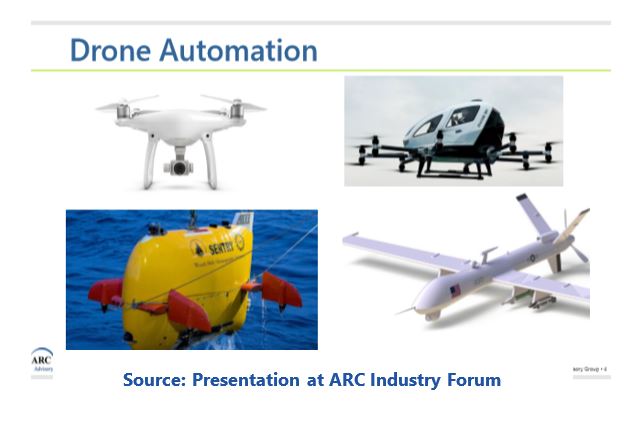

At the ARC Industry Forum in Orlando, Florida a panel discussion covered the topics of autonomous mobile robots (AMR) and drones in industry. Here, in Part 2, we’ll focus on drones, specifically safety and regulatory standards, business justification, and the future vision for deploying drones in various industry sectors.
The panelists for this discussion were Stephen Luxion, Executive Director, ASSURE; and Rick Rys, Senior Consultant, ARC Advisory Group. Steve Banker, Vice President, Supply Chain Management at ARC moderated the discussion.
The panelists, both speaking from the vantage point of industry expertise and experience, discussed the gap between regulatory policies and actual implementations, and responded to audience queries on issues ranging from using drones on construction sites to future plans.
Stephen Luxion began his military career flying fighter planes and later began flying UAVs. Now, he is the Executive Director of ASSURE (Alliance for System Safety of UAS through Research Excellence) led by Mississippi State University. ASSURE is the Federal Aviation Administration's (FAA) Center of Excellence for Unmanned Aircraft Systems (UAS). ASSURE provides the FAA a wide-ranging UAS research portfolio and conducts specific research funded by the FAA to help inform and address the key challenges to safely and efficiently integrating UAS into the National Airspace System.
Rick Rys has a broad background in industrial automation. He has worked in refining, chemicals, power, electric grid related functions, and software development. At ARC, he does research on drones and has completed a market analysis report on drone use in the construction industry and continues to track developments in use of drones in industry, infrastructure, and smart cities.
Mr. Luxion said that everything that was discussed earlier about ground robotics maps directly to the issues faced in the air, but is compounded by the complexity of flight and the level of safety. Because when the robot encounters a problem and is falling out of the sky, the situation is very different. Companies like Amazon have come up with creative solutions, but these must be integrated into the US National Airspace System (NAS).

Adding to that, Mr. Rys said that while drone applications for inspecting industrial facilities appear to be more advanced than for using drones for deliveries, they don’t always turn out to be a great fit. As an example of this, he mentioned that Duke Energy had researched all the different things they could use drones for, but ultimately determined that it wasn’t effective for transmission & distribution due to line-of-sight regulations for drones. Next, he spoke about the US FAA Part 107 regulations (see graphic) and the limitations these impose.
ARC Advisory Group clients can view the complete report at ARC Client Portal
If you would like to buy this report or obtain information about how to become a client, please Contact Us
Keywords: ARC Industry Forum, Panel Discussion, Drones, FAA, UAV, UAS, National Airspace, Safety, Standards and Regulations, ARC Advisory Group.

